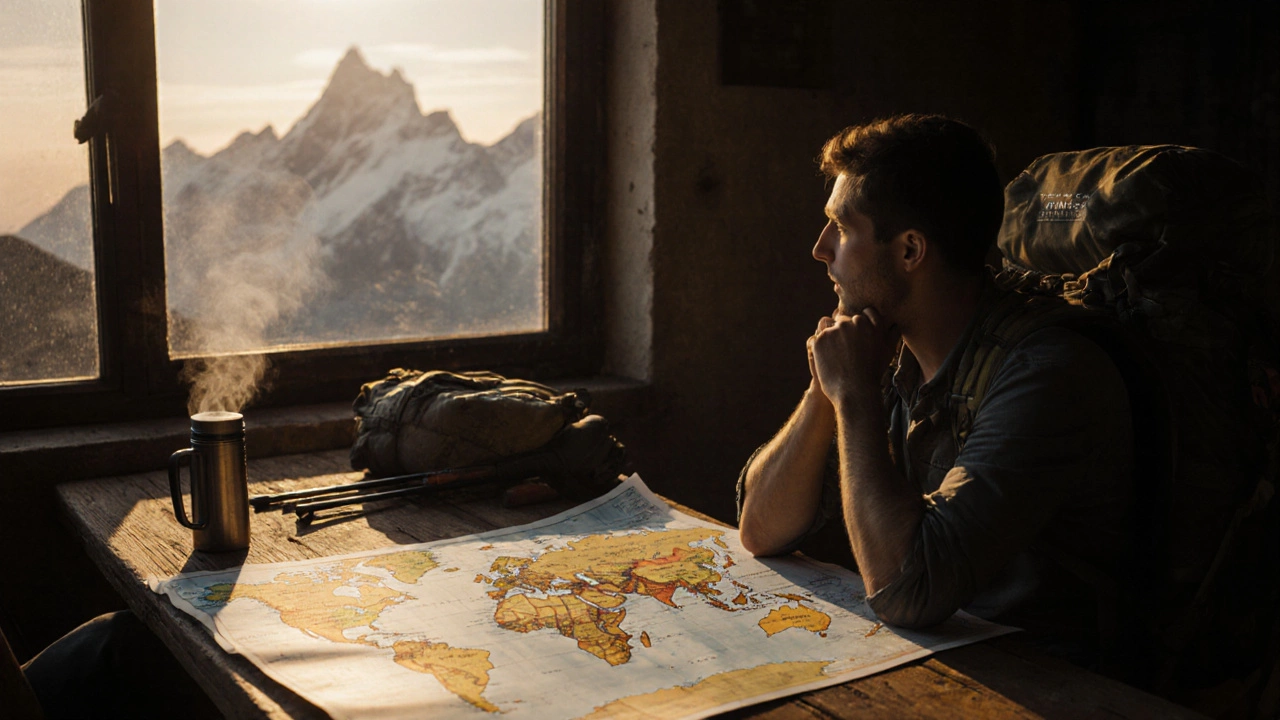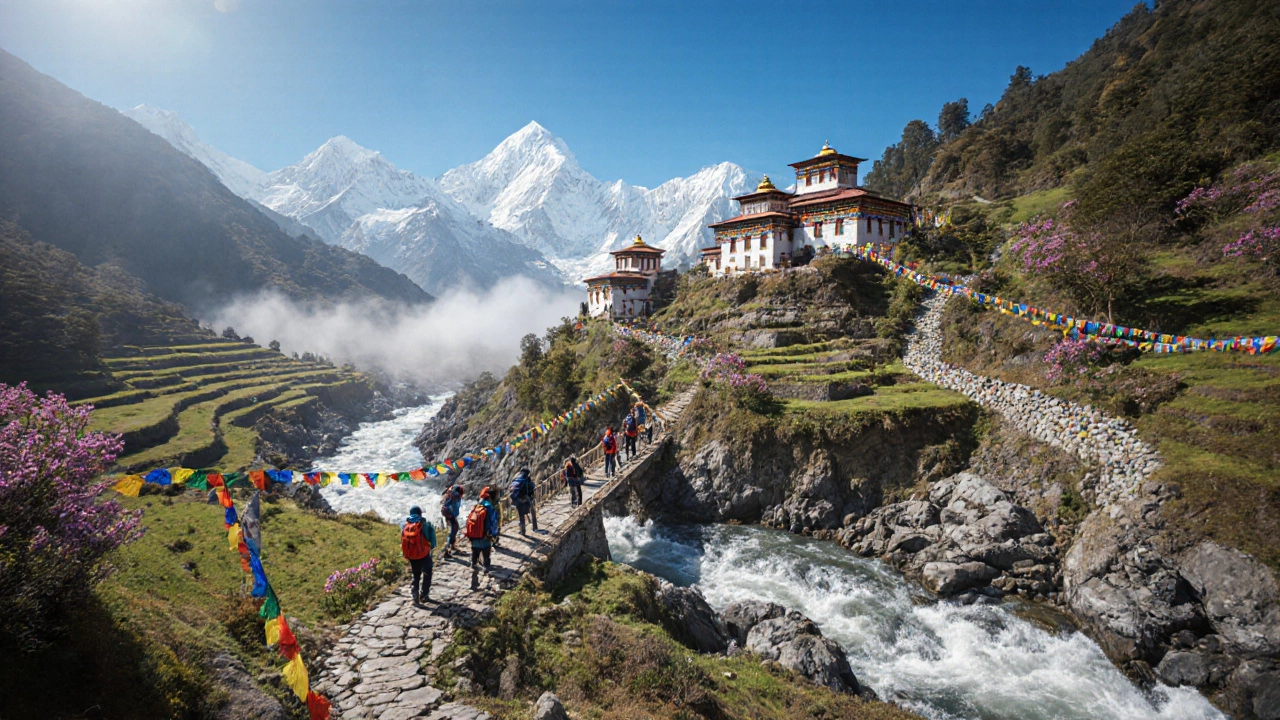Best Country for Trekking: Top Destinations Compared
 Oct, 26 2025
Oct, 26 2025
Trekking Destination Matchmaker
Find Your Perfect Trek
Recommended Treks
When you talk about Trekking is a multi‑day hike through natural terrain, often on remote trails and at high altitude, the first question on most adventurers' minds is: which place offers the ultimate experience? If you're hunting for the best trekking country, you’ll want to weigh scenery, trail infrastructure, safety, and the overall vibe of each destination. Below is a practical guide that walks you through the decision‑making process, ranks the top nations, and hands you a checklist to prep for your next epic trek.
Key Takeaways
- Asia (especially Nepal) and Oceania (New Zealand) dominate the list for sheer variety and iconic routes.
- South America’s Peru offers high‑altitude desert trekking with rich cultural stops.
- North America (Canada) and Europe (Switzerland) shine for well‑maintained trails and strong safety nets.
- Season, difficulty, and logistics differ widely - plan around the optimal months for each region.
- Invest in proper gear, altitude acclimatization, and local permits before you go.
How to Choose the Right Trekking Country
Every trekker has a slightly different wishlist. Use these five criteria as a quick filter before you dive into the country profiles.
- Scenery type: Do you crave alpine glaciers, desert plateaus, jungle valleys, or coastal ridges?
- Trail infrastructure: Look for marked paths, guesthouses, and reliable transport options.
- Altitude and difficulty: Beginners may want stays under 3,000 m, while seasoned hikers chase 5,000 m+ summits.
- Best season: Weather windows vary - you don’t want monsoons or winter snows unless that’s the goal.
- Cost and permits: Some nations charge hefty entry fees; others are virtually free.
Match your answers to the country snapshots below, and you’ll see which nation checks the most boxes.
Nepal - The Himalayan Classic
Nepal is a South Asian country home to eight of the world’s ten highest peaks, including Mount Everest. The Annapurna Circuit and Everest Base Camp trek are legendary for a reason: dramatic mountain vistas, vibrant Sherpa culture, and a well‑developed trekking economy.
- Notable trek: Annapurna Circuit (160 km, 1500‑5300 m)
- Best months: Late September‑early November and March‑May
- Difficulty: Moderate to hard (altitude can be a challenge)
- Permits: TIMS card + ACAP for restricted areas (≈ $30 total)
Why it works: The trail network is dense, teahouses are plentiful, and English‑speaking guides are easy to find. Altitude acclimatization is built into most itineraries, making the high passes more approachable.
New Zealand - Wilderness on the Edge
New Zealand is a Pacific island nation known for its dramatic fjords, volcanic peaks, and pristine alpine tracks. The Milford Track and the Routeburn Track offer compact, world‑class hikes with luxury-level hut infrastructure.
- Notable trek: Milford Track (53 km, 120‑600 m)
- Best months: December‑February (summer) for clear weather
- Difficulty: Easy to moderate (mostly low‑altitude)
- Permits: Department of Conservation (DOC) booking fee of NZ$30 per person
Why it works: Trail conditions are superb year‑round, and the country’s “backpacker” culture means you can find budget and high‑end options side by side. Plus, you’ll never run out of stunning photo ops.

Peru - Andean Adventure Meets Ancient Ruins
Peru is a South American nation that blends high‑altitude desert trekking with Inca archaeological sites. The classic Inca Trail to Machu Picchu draws thousands, but alternatives like the Salkantay and Ausangate treks provide quieter wilderness.
- Notable trek: Inca Trail (43 km, 2100‑4600 m)
- Best months: May‑September (dry season)
- Difficulty: Moderate to hard (steep ascents, altitude)
- Permits: Inca Trail permits limited to 500 per day; require booking 6‑12 months ahead (≈ $200)
Why it works: The cultural payoff of reaching Machu Picchu is unbeatable, and the high‑altitude desert landscape offers a stark contrast to the typical green‑mountain trekking found elsewhere.
Canada - Rocky Mountain Ruggedness
Canada is a North American country whose western provinces host the iconic Canadian Rockies. The West Coast Trail in British Columbia and the Skyline Trail in Jasper National Park are prized for wild coastline and alpine scenery.
- Notable trek: West Coast Trail (75 km, sea‑level‑800 m)
- Best months: July‑September (dry, warm weather)
- Difficulty: Hard (long distance, rugged terrain, river crossings)
- Permits: Parks Canada reservation system; fees≈ $30 per person
Why it works: Trails are well‑maintained, wildlife spotting is common, and the vast wilderness feels truly untouched. English‑speaking infrastructure makes logistics a breeze.
Switzerland - Alpine Perfection
Switzerland is a European country famous for its precision, chocolate, and some of the world’s most accessible high‑altitude trails. The Haute Route from Chamonix to Zermatt and the Tour du Mont Blanc (though it starts in France) showcase classic Alpine trekking.
- Notable trek: Haute Route (180 km, 800‑4000 m)
- Best months: June‑September (snow‑free passes)
- Difficulty: Moderate to hard (high altitude, glacier crossings)
- Permits: Generally none for public trails; some glacier sections require a guide (≈ $150 for guide)
Why it works: Infrastructure is immaculate, mountain huts provide hot meals, and public transport can drop you at trailheads, making multi‑day treks almost plug‑and‑play.
Quick Comparison of Top Trekking Countries
| Country | Iconic Trek | Altitude Range | Best Season | Typical Difficulty |
|---|---|---|---|---|
| Nepal | Annapurna Circuit | 1,500‑5,300 m | Sep‑Nov, Mar‑May | Moderate‑Hard |
| New Zealand | Milford Track | 120‑600 m | Dec‑Feb | Easy‑Moderate |
| Peru | Inca Trail | 2,100‑4,600 m | May‑Sep | Moderate‑Hard |
| Canada | West Coast Trail | Sea‑level‑800 m | Jul‑Sep | Hard |
| Switzerland | Haute Route | 800‑4,000 m | Jun‑Sep | Moderate‑Hard |
Practical Tips for Planning Your Trek
- Gear up early: A sturdy backpack (40‑50 L), waterproof trekking boots, layered clothing, and a reliable sleeping bag rated for the night‑time temperature of your highest camp.
- Acclimatize wisely: Ascend no more than 300‑500 m per day above 3,000 m, and schedule a rest day every 3‑4 days.
- Secure permits ahead of time: In high‑traffic routes (e.g., Inca Trail, Annapurna) permits sell out months in advance. Book through official agencies.
- Hire local guides when required: In Nepal and Peru, guides are mandatory on many routes and enhance safety and cultural insight.
- Stay hydrated and monitor altitude sickness: Drink at least 3 L of water daily, and know the symptoms of AMS-headache, nausea, dizziness.
- Travel insurance: Choose a policy that covers high‑altitude evacuation and trekking equipment loss.
Frequently Asked Questions
Which country is safest for beginner trekkers?
New Zealand usually tops the safety chart for newcomers. Trails are well‑marked, weather is predictable in summer, and the hut system provides shelter without the need for camping gear.
Do I need a visa for these trekking countries?
Visa requirements vary. Most Western travelers get a tourist visa on arrival or e‑visa for Nepal and Peru, while EU citizens can enter Switzerland visa‑free for up to 90 days. Check the latest embassy guidelines before you book.
What is the cheapest trekking destination?
Peru’s Salkantay Trek offers a low‑cost alternative to the Inca Trail, with dormitory‑style camps and fewer permit fees. Nepal’s Annapurna Circuit can also be done on a shoestring if you stay in basic tea houses.
When is the best time to avoid crowds?
For Nepal, the shoulder months of early March or late November see fewer trekkers. In New Zealand, late February offers warm weather with fewer crowds than the peak December‑January period.
Can I trek solo in these countries?
Yes, especially on well‑traveled routes like the Milford Track or the West Coast Trail, where you’ll meet other hikers. However, for high‑altitude treks in Nepal or Peru, a guide is strongly recommended for safety and navigation.
Next Steps
Pick the country that aligns with your preferred scenery, budget, and skill level. Then:
- Lock in the optimal season on the comparison table above.
- Secure any required permits or guide bookings.
- Create a gear checklist using the practical tips section.
- Book flights and plan your travel insurance.
- Start a fitness regimen 8‑12 weeks before departure to build endurance.
With a clear plan, you’ll be ready to lace up your boots and hit the trail in the country that truly feels like the best trekking destination for you.